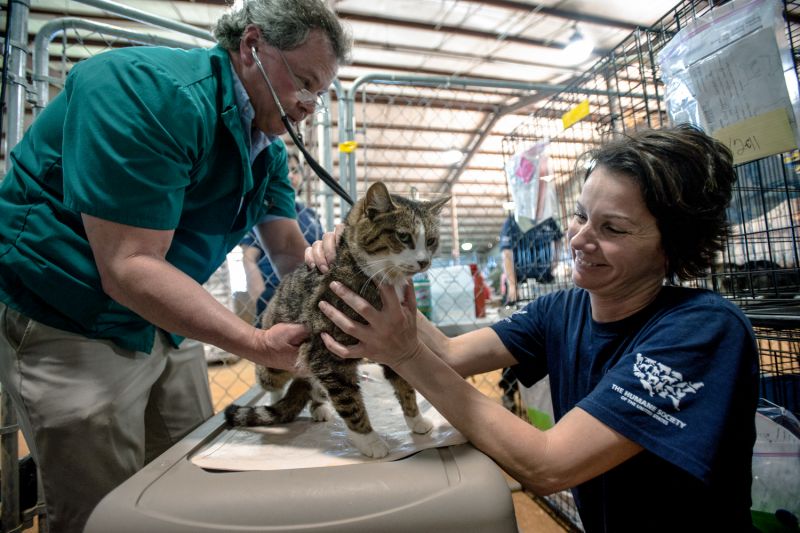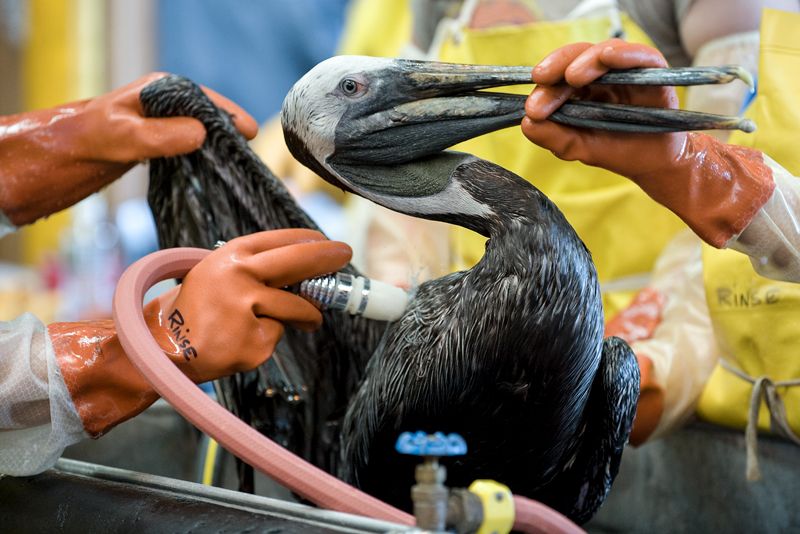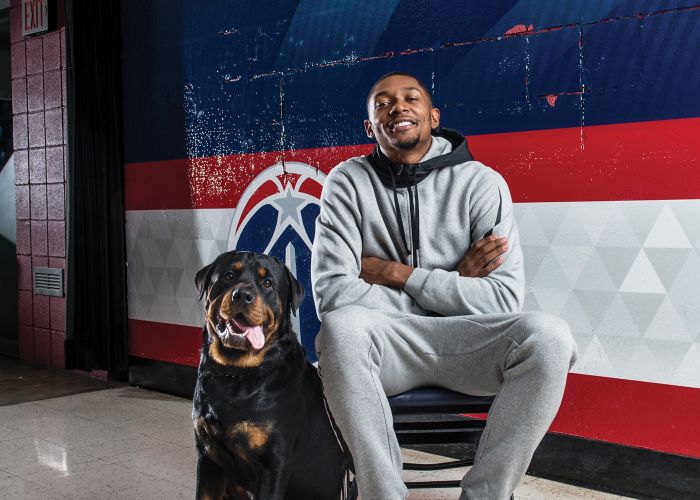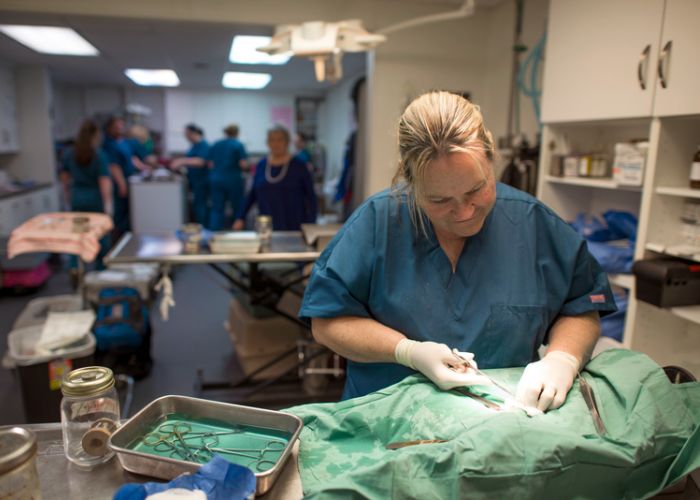Answering the call
When disaster strikes, veterinarians are key to successful rescue and response operations

Anyone who’s spent time in an animal shelter knows that disaster can strike at a moment’s notice. Whether it’s the discovery of a major hoarding case or a wildfire requiring sudden evacuations, a calm day can quickly turn into a chaotic one.
Natural disasters—such as hurricanes, tornadoes, fires and floods—may occur with little warning and often pose immediate dangers to animals and people. In cases of man-made disasters, shelters are more likely to have some forewarning to prepare. These situations can include dogfighting and cockfighting seizures; hoarding cases; neglect, abuse and cruelty investigations; and puppy mill cases.
Although the cause may be different, the results are typically the same: large numbers of animals and a variety of species in need of shelter, medical treatment and behavioral care. “The key to this kind of work,” says Sarah Kirk, a veterinary responder for the ASPCA’s Field Investigations and Response Team, “is to be flexible. Situations change quickly, and you have to be willing to work together for the common good. You will never work harder, physically or emotionally, than you will on these cases.”
Initial steps
While veterinarians already have years of specialized education, they need more training to become qualified and effective disaster responders. If a shelter is in a region where natural disasters occur frequently or if local agencies routinely require responses, shelters and veterinary professionals often become part of local or state disaster animal response teams, making it critical that team members understand the full nature of the response and of standard disaster protocols. Teams typically hold regular exercises so that members’ skills are fresh, they are prepared to deploy, and they are able to work cooperatively with other responding agencies and staff members.
Most animal disaster responders must complete several online courses required of all first responders through the Federal Emergency Management Agency (FEMA) Emergency Management Institute to learn about the Incident Command System (ICS), and many complete additional extensive training. Kirk, for example, has completed multiple levels of training on the ICS as well as large animal technical rescue, confined space and rope rescue training, and she is in the process of completing a master’s in shelter medicine.
For veterinarians to deploy and practice medicine on the scene of a disaster, they typically must be licensed in the state where they’ll be working. Exceptions to this rule can be made, such as when a state of disaster is declared by the president, or when the governor of a state declares a disaster and activates an Emergency Management Assistance Compact, enabling state-to-state sharing of resources. Veterinarians should be certain they have liability coverage, either through their own provider or through states’ Good Samaritan laws. Federal Drug Enforcement Administration (DEA) licensure is state-specific, and DEA-controlled substances should only be handled by veterinarians who are DEA-licensed within the affected state.

Assessing the situation
In the early stages of a disaster, veterinary teams may need to provide triage, intake and medical assistance to animals in the field or as they arrive at shelters. As things progress, shelter medical personnel become responsible for managing and preventing infectious disease and maintaining a healthy environment for people and animals. Your role may be different depending on when you arrive during the course of the incident response; while some disaster situations resolve quickly, in others, a temporary shelter may be needed for months or even years.
The first medical step in evaluating patients in any disaster is triage, which is generally an ongoing process. Animals may first be assessed where they are found in the field to determine their immediate medical needs and whether to route them to a shelter or other care facility based on available local resources. Effective triage and subsequent intake can make or break a sheltering operation, and these are touchpoints where skilled veterinarians are essential.
Field triage should be done in a systematic, decisive manner by a veterinarian who can rapidly examine the basic organ systems of the patients and identify those with the most severe injuries or infectious disease issues. Generally, the immediate goal of field triage is not to provide emergency care on the spot. Instead, it is to examine and rapidly categorize animals based on the resources each will need and where their care needs to occur.
Examples of such categories are: 1) Likely to survive whether or not they receive care; 2) Critical—may survive with critical care; and 3) Dead or likely to die. These categories align with what is known as the “SAVE” system of triage, or the Secondary Assessment of Victim Endpoint, which is designed to help first responders make decisions for the good of the greatest number of victims in severe situations.
Triage should occur again prior to shelter intake. Shelter medical personnel should briefly evaluate animals for signs of health, injury, infectious disease or requirements for more intensive care than the shelter can provide and route animals accordingly.
In some situations, animals may have been exposed to contaminated environments, such as floodwaters or a hoarding home, so a decontamination station may be needed. Procedures for decontamination are generally established by a trained safety officer on scene, who is part of the incident command staff managing the disaster. Any participating personnel will need to have had appropriate training and clearance. Most veterinarians won’t have that clearance; in many situations when decontamination is needed, it will need to occur prior to the medical examination for the health and safety of the veterinarians. After the decontamination and the intake exam, animals can then be safely routed to shelter housing areas.
The ins and outs of intake
During actual intake, a lot has to happen rapidly. Intake is one of the most important times for identifying health issues and preventing the spread of infectious disease, and veterinarians should participate in the entire process. (See the Resources box below for a link to a standardized intake form.)
Each animal’s triage status should be recorded on the intake form so that any changes can be documented during the shelter stay. Veterinarians assisting should be sure their names and license numbers are recorded on the forms as well, as a matter of recordkeeping and in case any follow-up is required. Each animal should be carefully identified on intake and given a unique identification number. Responders should make sure that photographs are taken for identification purposes in all cases, and each photo needs identifying information such as an animal ID number and date. In the event of a situation where the animal will likely be returned, the owner can be included in these photographs to help later with reunification.
Each animal should also be scanned for a microchip with a universal scanner, have a collar marked with identification and have a microchip inserted if the scan is negative. Make sure paperwork distinguishes between owned and stray animals; if an owner is present, try to get a brief medical history, with emphasis on the animal’s current medical needs. Behavior should also be assessed during intake, ideally by a trained individual. Any aggression should be clearly noted, and potentially dangerous animals should be housed in an area where they do not pose a risk to staff or other animals.
As part of the examination process, animals should be weighed, vaccinated with core shelter vaccines, treated for internal and external parasites, and have any necessary diagnostic testing performed. Diagnostic testing will vary depending on the situation, species, presenting clinical issues and resources available. Simple equipment like stethoscopes, otoscopes, refractometers, microscopes and hematocrit centrifuges is usually—but not always—available in these situations.
In general, tests that are commonly performed in emergency shelters include checks for the packed cell volume and total protein, blood glucose evaluation, urinalysis exams, fecal examinations and bedside ELISA tests for canine parvovirus and feline panleukopenia virus, FeLV/FIV and heartworm antigen tests. More advanced diagnostics are often done but may require resources not available on site. Each of these aspects of intake helps to ensure a positive outcome for not only an individual animal, but also the whole sheltering population.

Ongoing care
In large-scale disaster situations, new patients may arrive daily, and just as in a brick-and-mortar shelter, protocols are needed in temporary housing facilities to ensure that everyone follows the same steps each day, even when changes in staff or situations occur. Animals will need to be observed daily via medical rounds and examined with regular veterinary rechecks. Follow existing protocols for the recognition, management and treatment of common infectious diseases like upper respiratory infections, canine parvovirus, ringworm and gastrointestinal issues, among others.
Biosecurity and sanitation concerns are particularly important in temporary shelters and need to be outlined early and clearly. Every shelter will require a clearly labeled isolation area where animals with potentially communicable diseases can be isolated from the general population. Veterinarians can play an important role in assessing the facility, paying attention to the flooring surface, which affects disinfection protocols.
Some response teams find it useful to keep an ever-evolving binder of standard operating procedures (SOPs) for these critical aspects of sheltering. In other situations, it falls to the responding team to develop a working plan specific to the situation.
Euthanasia is one of the most difficult aspects of this work. At a minimum, veterinarians should follow the current AVMA guidelines for euthanasia in addition to local and state laws. Photographs and a written description of the animal with location, date, time and identification number are necessary. It’s always best to prepare decision-making protocols and procedures for providing humane euthanasia, even if it turns out that euthanasia is not necessary.
The public often criticizes veterinarians and responding agencies for euthanasia decisions made during disasters. These are situations that require preplanning and post-situational debriefing for the responders, who may experience significant stress and related compassion fatigue. If responders are experiencing signs of compassion fatigue—such as exhaustion and depression that extend beyond two weeks—they should contact their primary care physician to rule out physical concerns and provide a recommendation for counseling.
“Be honest with yourself about what you can handle,” advises Eller Medina, a large-animal veterinarian who’s worked on disaster response for the ASPCA. “Every day there will be things that you see and have to do that will break your heart, but you need to continue to approach it all from love.”
What keeps people returning to this difficult work again and again? The hours are long, the conditions can be Spartan, and the cases are often overwhelming. It is difficult to put into words what a responder takes away from such an experience. Perhaps it is something of the animals’ resilience that is both humbling and inspiring. Perhaps it is the experience of necessary, focused teamwork driving toward a common good. Whatever “it” is, working disasters is an experience many responders say they’ll never forget. The animal welfare community needs shelter medicine professionals to engage in community disaster preparedness. Consider getting involved!







